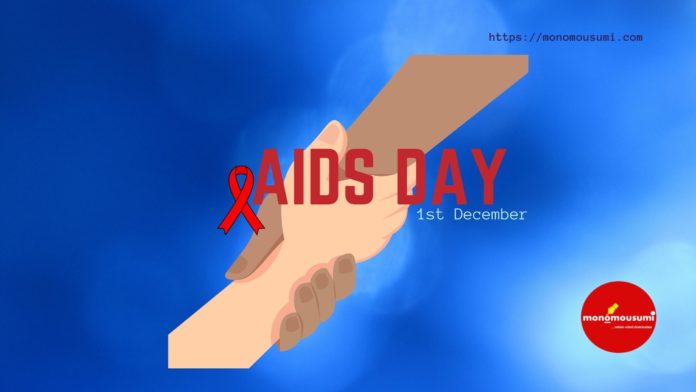We know and celebrate many kinds of festivals, and not only festivals, it is not necessary that things related to spiritual or religious festivals shall be celebrated, any discovery or any new thing was found or made on a day is given a name to be remembered whole life. Similarly, doctors and scientists had discovered a very rare disease and named it AIDS (Acquired Immune Deficiency Syndrome) and is observed on 1st December everywhere in the world as AIDS Day. Something most dangerous about this disease is that it still has no cure!
If we see the past diseases, around 1959, doctors and researchers discovered HIV in a stored plasma. Dr. Michael Gottlieb with Elizabeth Taylor started working on it. At that time when AIDS had come or was formed, people used to call it as a “mysterious lung infection”. Dr. Michael Gottlieb was an immunologist at UCLA, he had written an article which was published. Following his article physicians from many countries, mostly, from New York, San Francisco and other cities reported that their patients were dying had symptoms were similar to Dr. Michael’s patients’. The first full-blown cases were tested and detected in Los Angeles, California in 1981. The agent responsible for this disease, HIV, was isolated. At the most cases of HIV/AIDS, the patients were diagnosed homosexual, the virus had spread through sexual contact, had spread through sexual contact, Intravenous drug use, vertical transmission and shared razors/ needles. The prevalence of the infection can be reduced significantly by the preventive strategies including use of condoms, precautions during childbirth, disposal of used needles/blades, no sharing of personal razors. While breastfeeding also accounts as a risk factor but in India exclusive breastfeeding is done in HIV positive mother as malnutrition and poverty still are a major cause of infant mortality. In the year, 1985 serology tests to detect the virus had been developed.
Doctors said, this is not a contagious disease nor it can’t be spread through coughing, sneezing or any physical contact. But in some societies people consider it in some other ways, they think that they’ll be infected if they come in contact with an AIDS patient! But it is not true. So, we should support the AIDS patient and help them for their rehabilitation the major mode of communication world wide-that which accounts for 70 per cent of all HIV infections- is heterosexual intercourse. It can be also spread when a new born baby is fed through mother’s breast milk. In India, breastfeeding is done even for HIV positive mother, because malnutrition in India is more prevalent and most people cannot afford the baby food.
The most cases were seen in December 1996, there had been more than 8 million cases of AIDS worldwide, and it resulted in 6 million deaths. It was assessed that approximately 750,000 individuals in the United States and 23 million individuals throughout the world were infected with HIV. It occurred more than 90 per cent of HIV in developing the countries. The resources weren’t so developed that they could resume their office work. Poverty had increased. Sub- Saharan Africa accounted for more than 60 per cent of cases of HIV and in some regions of the continent almost one third were infected. In our nation, India, in 1998 was almost 3 million cases. Doctors observed various changes and symptoms in the body, it was general malaise, nausea, joint and muscle soreness, fever, rash, sore throat, diarrhea, stiffness, swollen lymph glands, dementia, and unexplained weight loss. People were suffering from these because our immune system is not so strong anymore! And this is the biggest bad affect in the body. HIV-infected individuals have an unusually high incidence of certain cancers, such as Kaposi’s sarcoma, tongue and rectal cancers, and non-Hodgkin’s B cell lymphoma. The development of one or more of these conditions usually marks the start of AIDS. In many diseases, Pneumonia is a common disease seen in AIDS patients. Very fewer people can survive from HIV longer than 10 years without developing AIDS. They show no sign of developing. There are such individuals, whose immune system are so strong that they weak the virus, or the virus fails to attack on him or her. There are two strain of HIV, HIV-1 and HIV-2. The way of attack of both strains are similar, the difference is HIV-2 causes a form of AIDS but its progress is very slower than that caused by HIV-1. There is no cure for HIV/ AIDS, but if we follow all the ways told by the doctors, we’ll be safe whole life from such immune affecting virus. People shouldn’t smoke and should eat all fruits filled with ingredients which keeps our immune system strong. And to check all these, there are certain tests should be done at least twice in a year-
• Enzyme Linked Immunosorbent Assay (ELISA)
• Radio Immune Precipitation Assay/ Indirect Fluorescent Antibody Assay (RIP/ IFA)
• Polymerase Chain Reaction (PCR)
• Western Blot Confirmatory Test
After all of these, we on World Aids Day, we observe this in order to take a chance to unite everyone across the world to create awareness about the disease.
By Amartya Saha, Greater Noida















